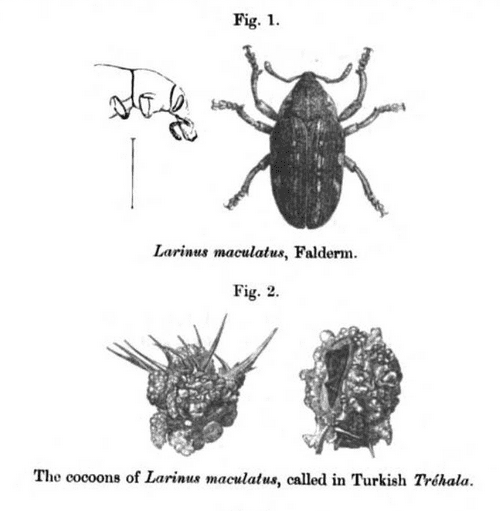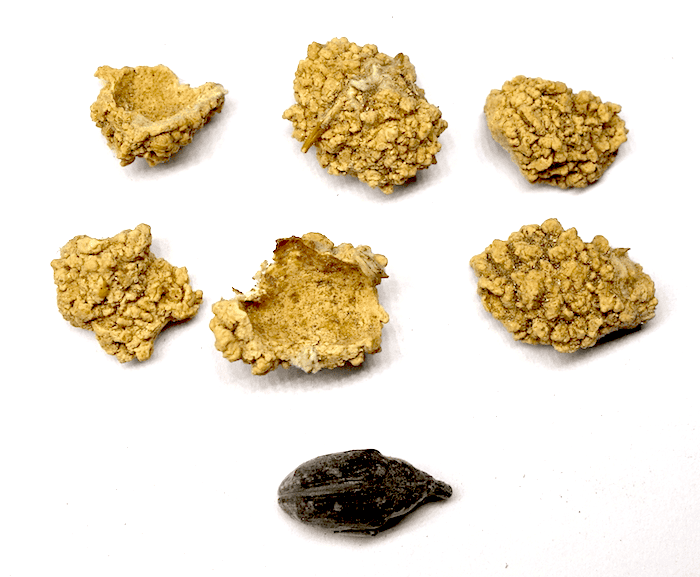Larinus Cocoon, Shakar Teghal
Honeydew, Trehala MannaShakar Teghal (‘Sugar of Nests’) (Unani)
Trehala (Turkish)
Qand Teghal (Persian)
Shakara Tagara (Hindi)
 Science Papers, Hanbury, 1876
Science Papers, Hanbury, 1876 Hemiptera Cocoon (Shakar Teghal) with insect at bottom.
Hemiptera Cocoon (Shakar Teghal) with insect at bottom.(Calcutta Unani Medicine College, Adam, 2019)
Entomological name:
Larinus maculatus, L. mellifera
Parts used:
Cocoon of Larinus maculatus, principally found on Echinops persicus
Irregular pieces of dirty-white color, oblong, oval or irregular in shape, hollow within, usually with a black pupa inside.
Temperature & Taste:
Neutral (slightly Warm, moist). Sweet, slightly Pungent
Constituents:
Composition varies with the tree that it feeds on.
Hexoses, sucrose, melezitose, erlose, disaccharides (inc. trehalulose), trisaccharides (inc. bemisiose)
Uses:
1. Benefits Brain, Settles Wind, Stops Spasms:
-Hysteria
-increases Memory and Cognition
2. Strengthens the Kidneys:
-Edema; Kidney diseases
-Diabetes (proven hypoglycemic effect)
3. Nourish Lung Yin, Stops Cough:
-Chronic Cough, Bronchitis, Asthma, Shortness of Breath
-Tuberculosis
4. Opens Obstructions, Clears Heat and Damp:
-Heartburn
-Jaundice
-Gonorrhea
-Gout
-Constipation, Obesity
Dose:
Powder: 500mg–1 gram in powder (2 grams can be used short-term)
Apparently used in decoction for Cough, but doses are uncertain.
Main Combinations:
1. Chronic Cough:
i. Hemiptera Cocoon, Almond, Pistachio, Ginger, Mimusops bark, Babul (Indian Gum Arabic) (equal parts)
ii. Hemiptera Cocoon with Sebesten, Jujube, Fig, Raisins stoned, Licorice, Mallow seed, Maidenhair, Hyssop, Poppy seed (as in Laooq Sapistan)
2. Asthma, Hemiptera Cocoon, Round Birthwort, Arsenic prepared, Calotropis latex, Acacia nilotica gum
Major Formulas:
Laooq Sapistan
Cautions:
1. None noted in Traditional texts.
2. Should not be used in full doses for more than 2–3 weeks without a break in treatment. Best avoided in those with Kidney or Liver disease.
Toxicity:
Acute toxicity studies showed no detrimental effect in Mice. However, chronic administration (50–100mg/kg) resulted in loss of appetite, reduction in movement, as well as histopathological changes. (See here) It should be noted that the primary species the Cocoon is collected from is Echinops spp. which is known to contain pyrrolizidine alkaloids. Many samples available on the market contain significant plant matter, particularly stalks to which the Cocoons are attached. The plant matter may be responsible for noted negative effects on the Liver and Kidneys in mice, or else perhaps the alkaloids are found in the Cocoons.
